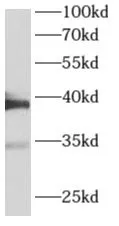ACSL5 antibody - 100 µg
Host : Rabbit
Clonality: Polyclonal
Clone:
Isotype: IgG
Immunogen: acyl-CoA synthetase long-chain family member 5
Purity: ≥95% as determined by SDS-PAGE
Form: Liquid
Molecular weight: 70 kDa
Uniprot: Q9ULC5
Gene id: 51703
Background: Acyl-CoA synthetases(ACSL) activate long-chain fatty acids for both synthesis of cellular lipids, and degradation via beta-oxidation. ACSL5 may activate fatty acids from exogenous sources for the synthesis of triacylglycerol destined for intracellular storage(By similarity). Utilizes a wide range of saturated fatty acids with a preference for C16-C18 unsaturated fatty acids(By similarity). It was suggested that it may also stimulate fatty acid oxidation(By similarity). At the villus tip of the crypt-villus axis of the small intestine may sensitize epithelial cells to apoptosis specifically triggered by the death ligand TRAIL. May have a role in the survival of glioma cells.
Field of research: Metabolism
Storage conditions: PBS with 0.02% sodium azide and 50% glycerol pH 7.3, -20°C for 12 months(Avoid repeated freeze
thaw cycles.)
Applications: ELISA, WB, IP
Dilution: WB: 1:500-1:5000; IP: 1:200-1:2000
Target: ACSL5
Purification: Immunogen affinity purified
Reactivity: Human, Mouse, Rat

Clonality: Polyclonal
Clone:
Isotype: IgG
Immunogen: acyl-CoA synthetase long-chain family member 5
Purity: ≥95% as determined by SDS-PAGE
Form: Liquid
Molecular weight: 70 kDa
Uniprot: Q9ULC5
Gene id: 51703
Background: Acyl-CoA synthetases(ACSL) activate long-chain fatty acids for both synthesis of cellular lipids, and degradation via beta-oxidation. ACSL5 may activate fatty acids from exogenous sources for the synthesis of triacylglycerol destined for intracellular storage(By similarity). Utilizes a wide range of saturated fatty acids with a preference for C16-C18 unsaturated fatty acids(By similarity). It was suggested that it may also stimulate fatty acid oxidation(By similarity). At the villus tip of the crypt-villus axis of the small intestine may sensitize epithelial cells to apoptosis specifically triggered by the death ligand TRAIL. May have a role in the survival of glioma cells.
Field of research: Metabolism
Storage conditions: PBS with 0.02% sodium azide and 50% glycerol pH 7.3, -20°C for 12 months(Avoid repeated freeze
thaw cycles.)
Applications: ELISA, WB, IP
Dilution: WB: 1:500-1:5000; IP: 1:200-1:2000
Target: ACSL5
Purification: Immunogen affinity purified
Reactivity: Human, Mouse, Rat

